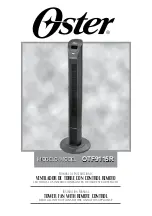
APPENDICES
Table 1. Troubleshooting Guide.
Symptom
Cause
Solution
Poor airflow
Plugged outside hood 1/4 in. (6 mm) mesh.
•
Clean exterior hoods or vents
•
Filters plugged.
•
Remove and clean filter.
•
Core obstructed.
•
Remove and clean core.
•
House grilles closed or blocked.
•
Check and open grilles.
•
Dampers (if installed) are closed.
•
Open and adjust dampers
•
Poor power supply at site.
•
Have electrician check supply voltage at house.
•
Ductwork is restricting airflow.
•
Check duct installation.
•
Improper speed control setting.
•
Increase speed of ventilator.
•
Ventilator airflow improperly balanced.
•
Have contractor balance ventilator airflow.
•
Supply air
feels cold
Poor location of supply grilles, airflow can
•
irritate the occupant.
Locate grilles high on walls or under baseboard
•
heaters; install ceiling-mounted diffuser or
grilles to avoid blowing directly on occupants
(example: over a sofa).
Outdoor temperature extremely cold.
•
Turn down ventilator supply speed.
•
Use a small duct heater (1 kW) to temper the
•
supply air.
Placement of furniture or closed doors is
•
restricting movement of air in the home.
If supply air is ducted in furnace return, run
•
furnace fan continuously to distribute ventilation
air comfortably.
Ventilator airflow can be incorrectly balanced.
•
Have a contractor balance ventilator airflow.
•
Dehumidistat
is not
operating
Incorrect connection to external 24-volt control.
•
Staple/nail is shorting out external low voltage.
•
Check that correct wires were used.
•
Check external wiring for a short.
•
Check dehumidistat setting; it could be at Off.
•
Set dehumidistat at the desired setting.
•
Dehumidistat is disabled when the outdoor
•
temperature is above 60F for 24 hours.
Check the LED on the terminal block for long
•
flash followed by a short flash.
TROUBLESHOOTING
HR150, 200; ER150, 200 Perfect Window™ Fresh Air Ventilation Systems 68-0171—12
18









































